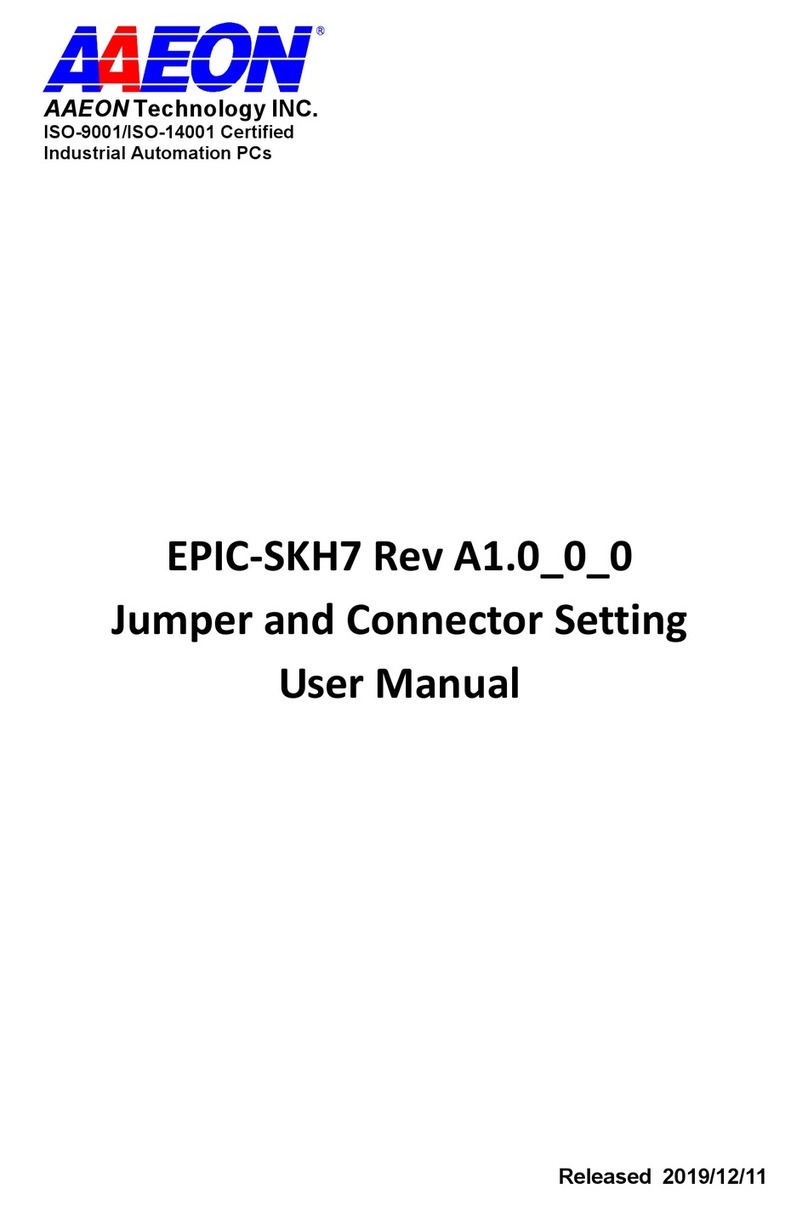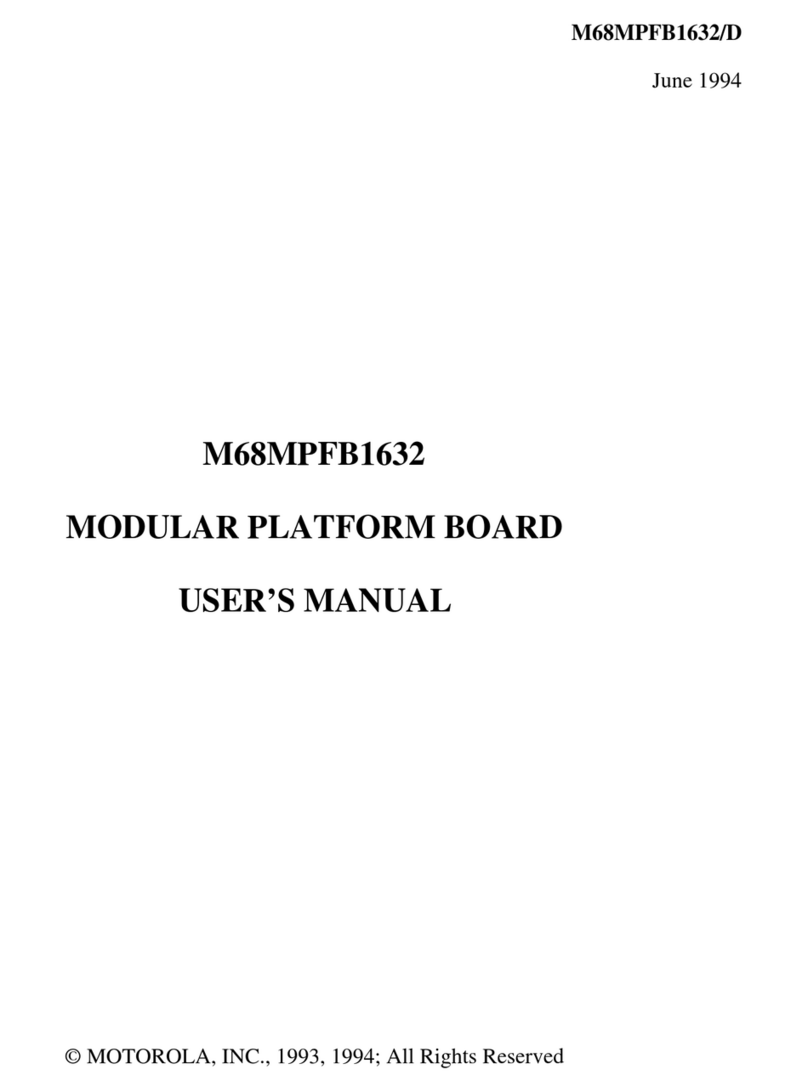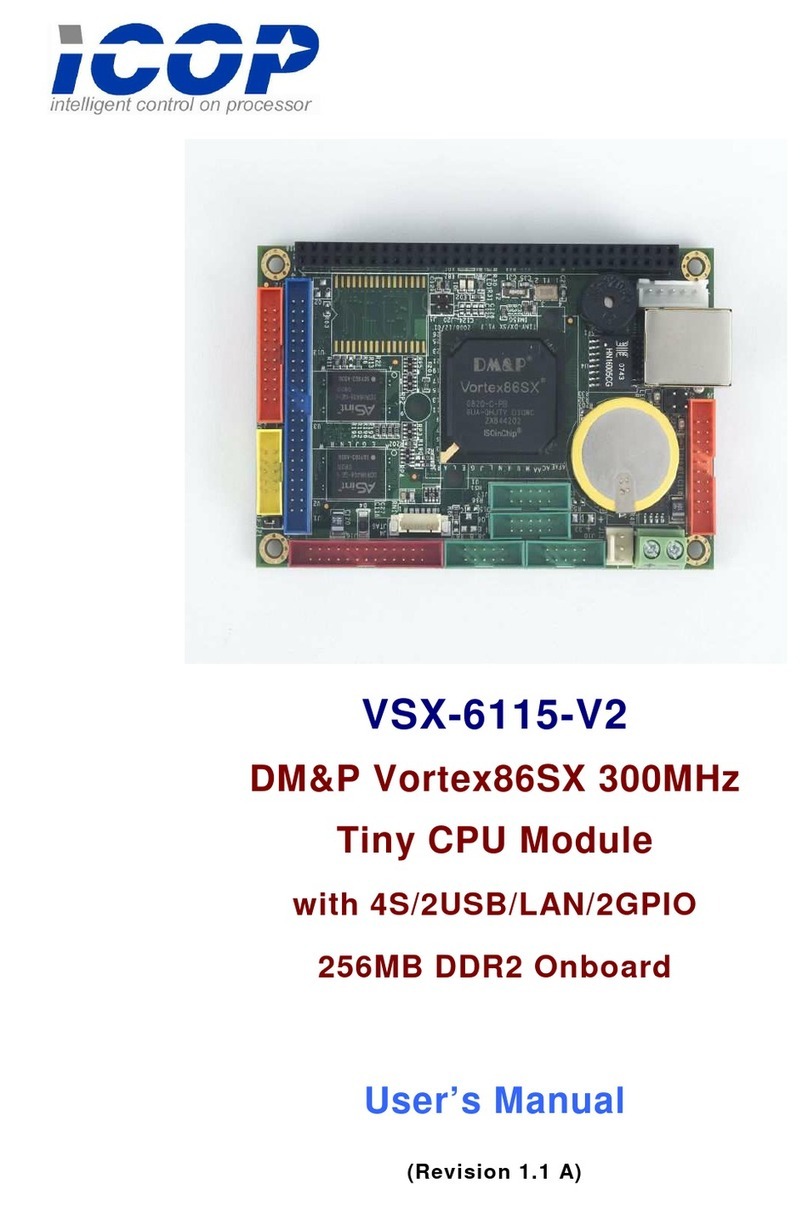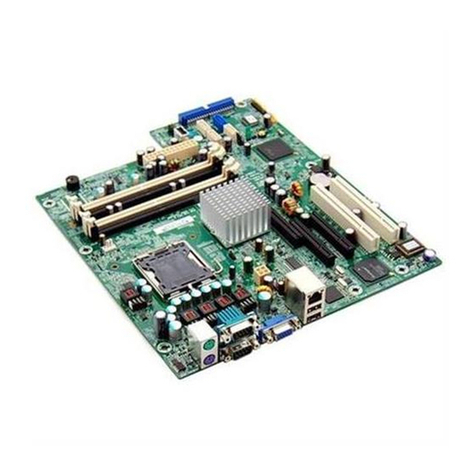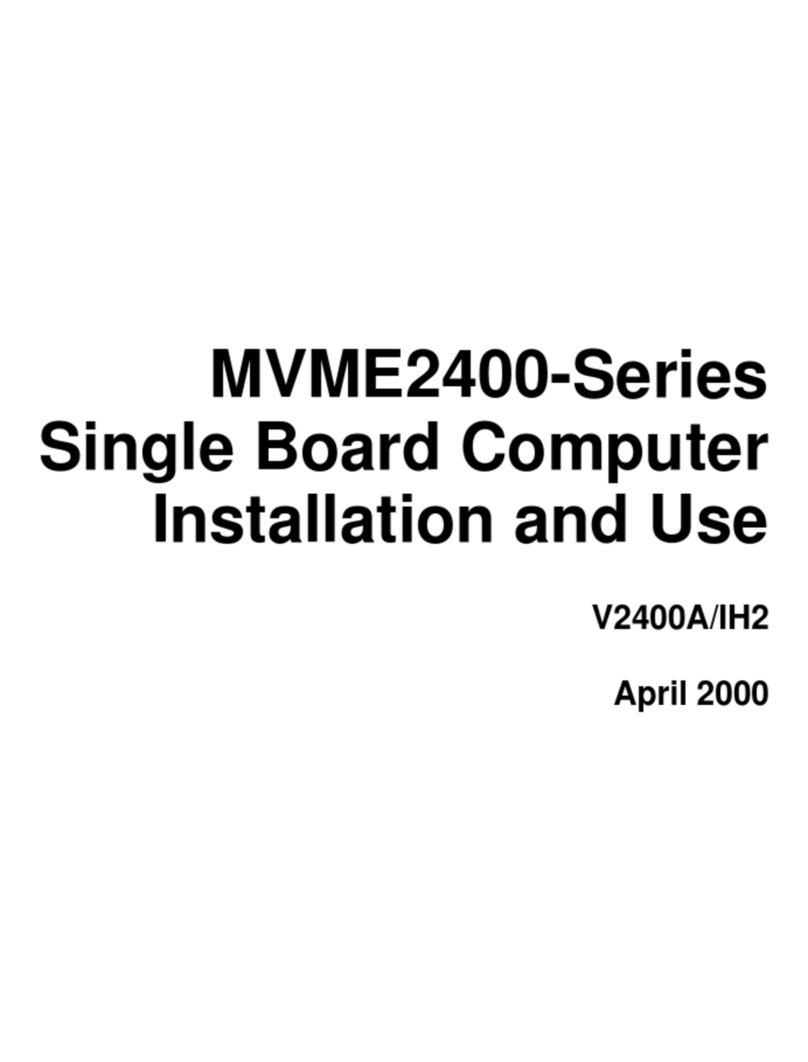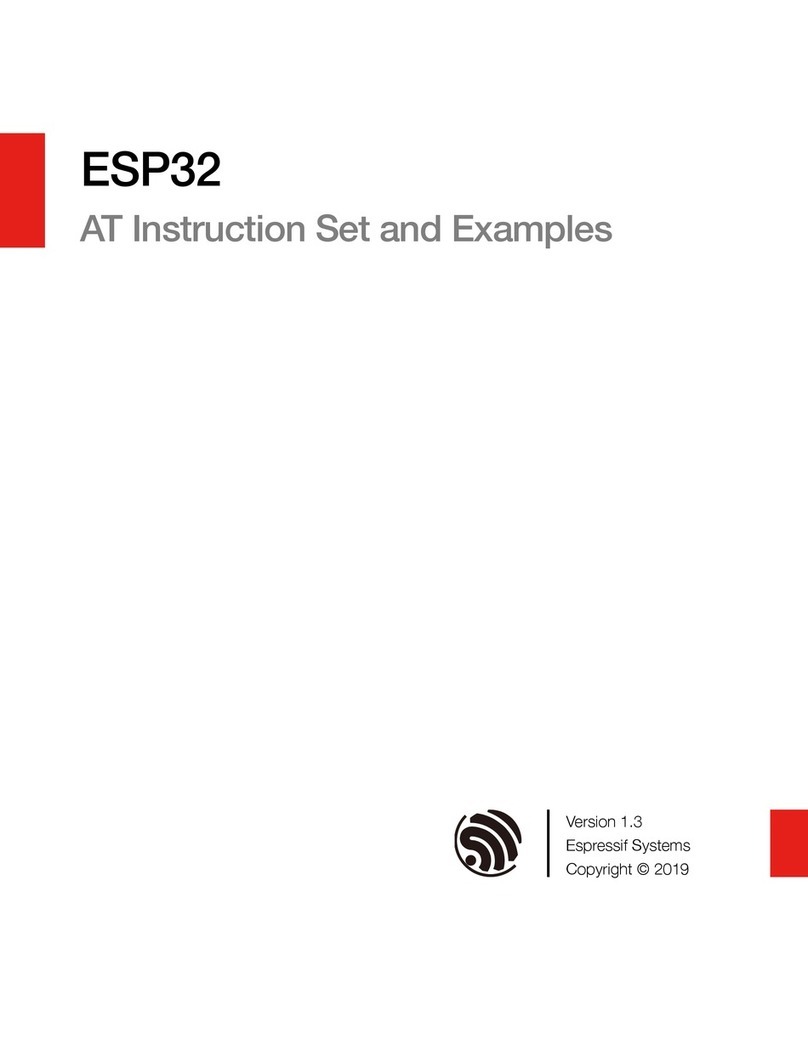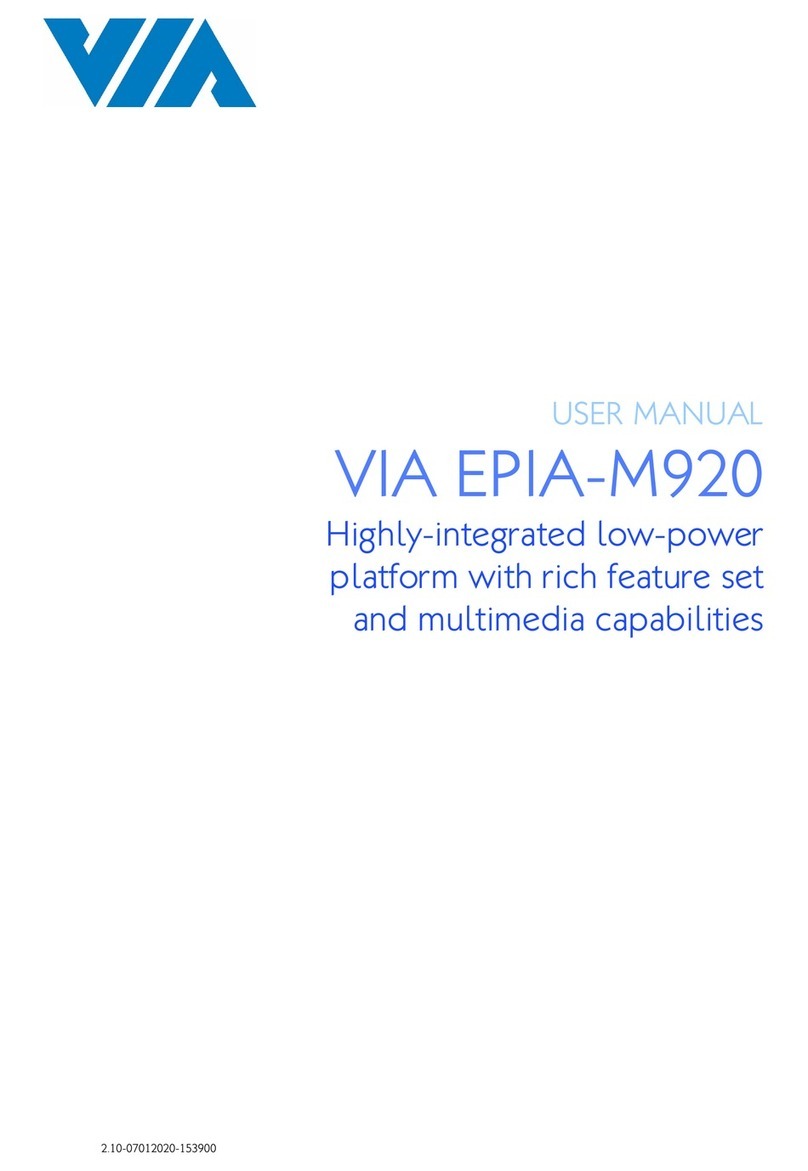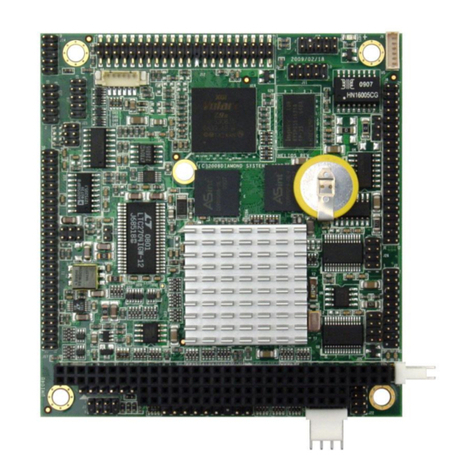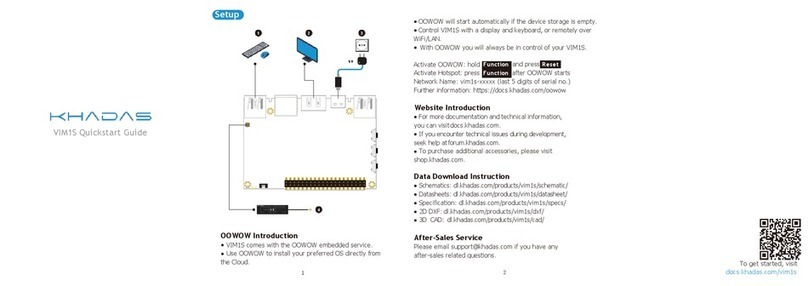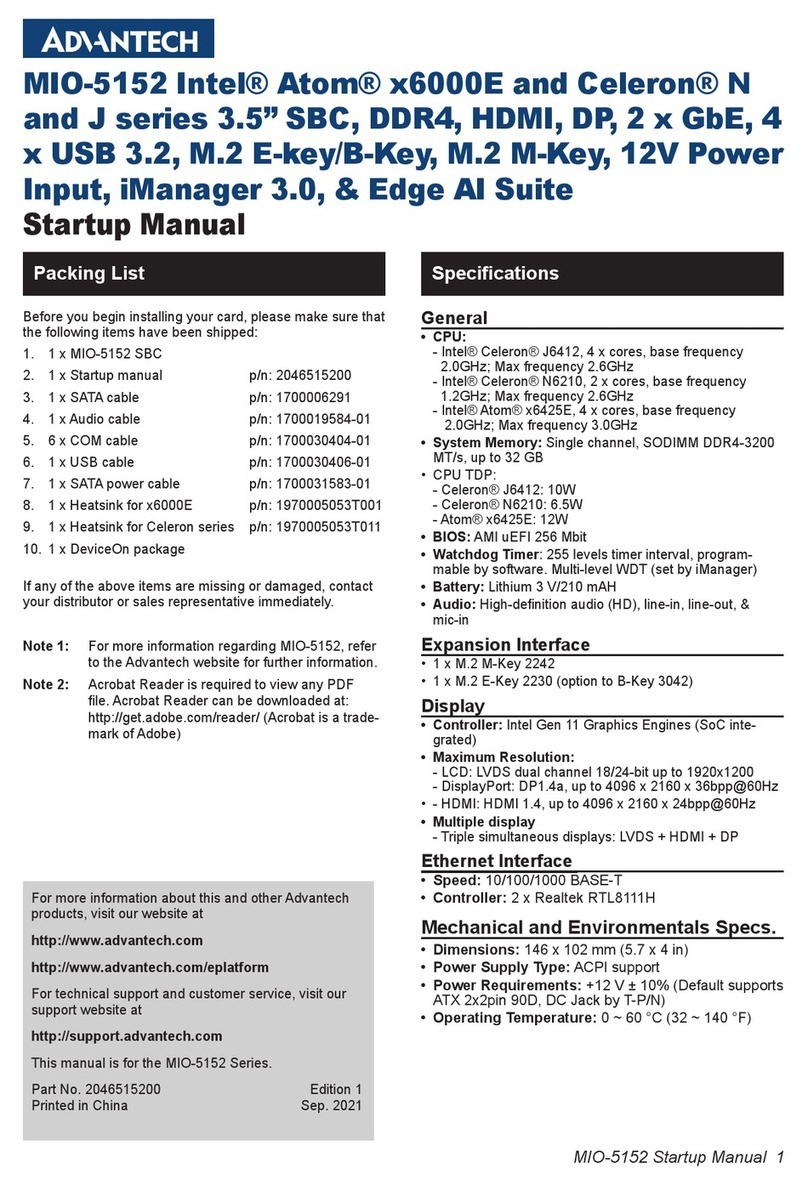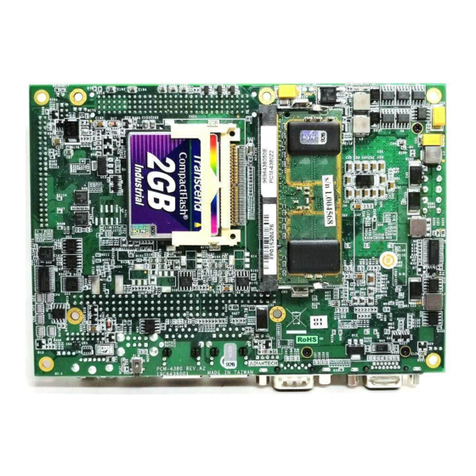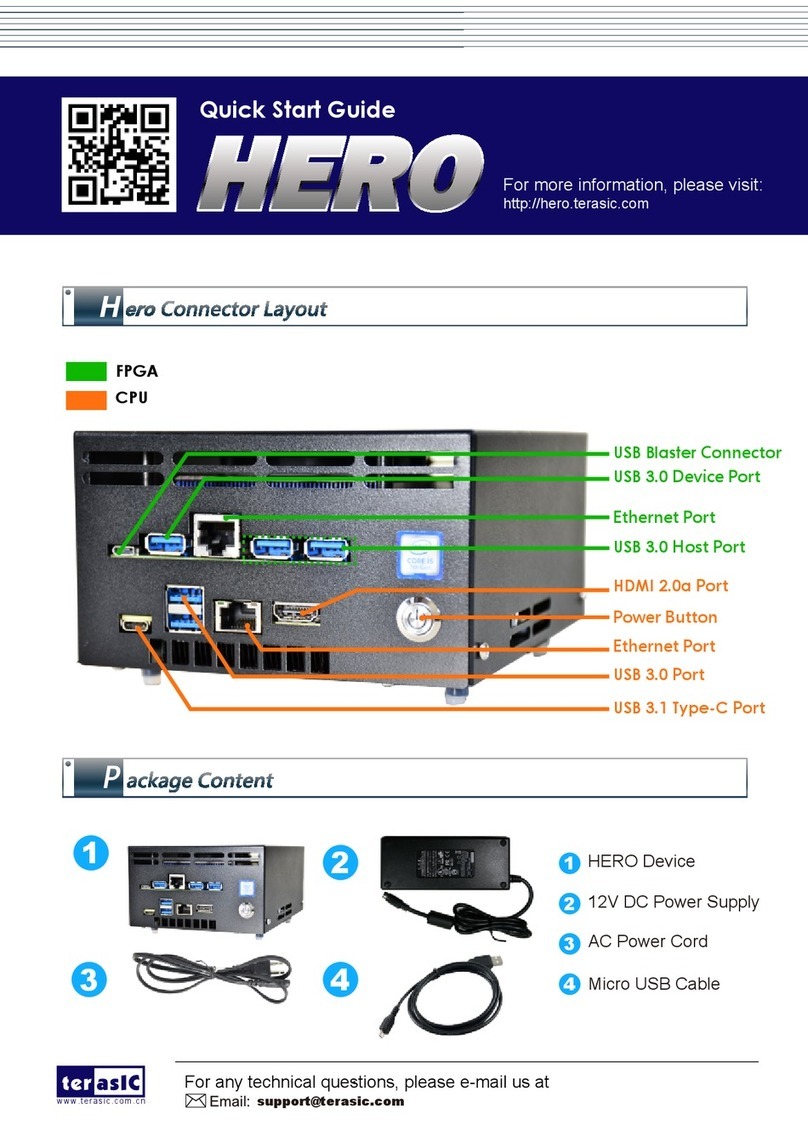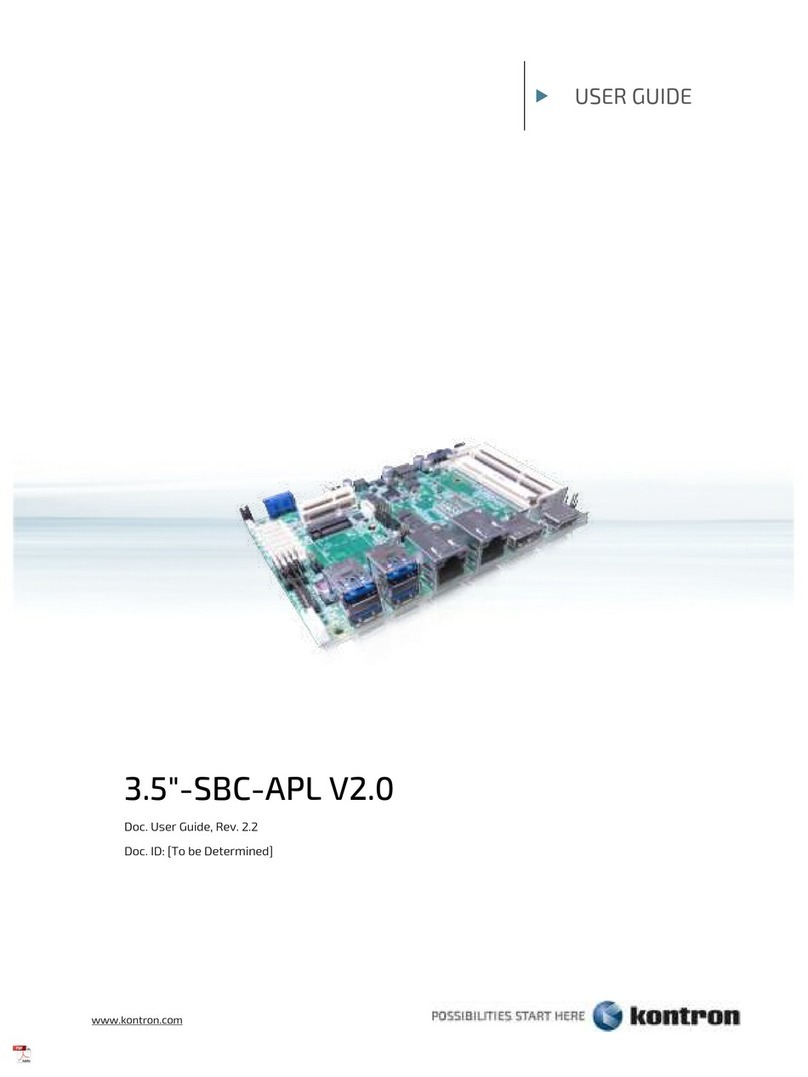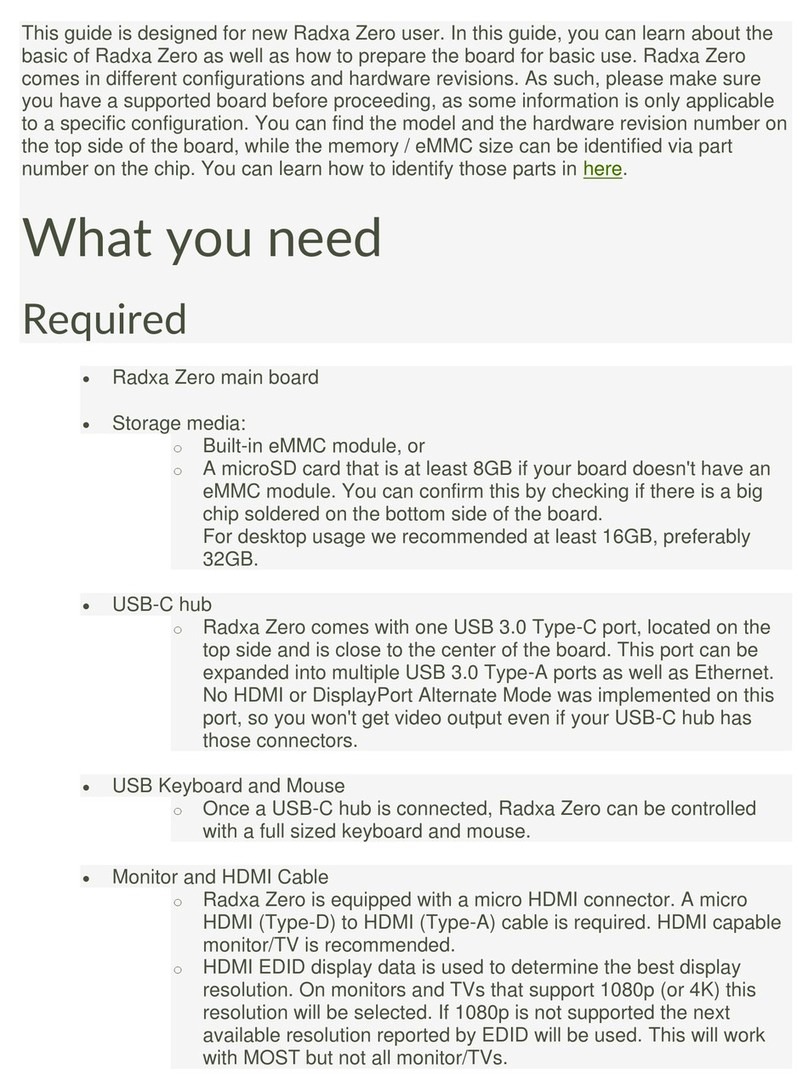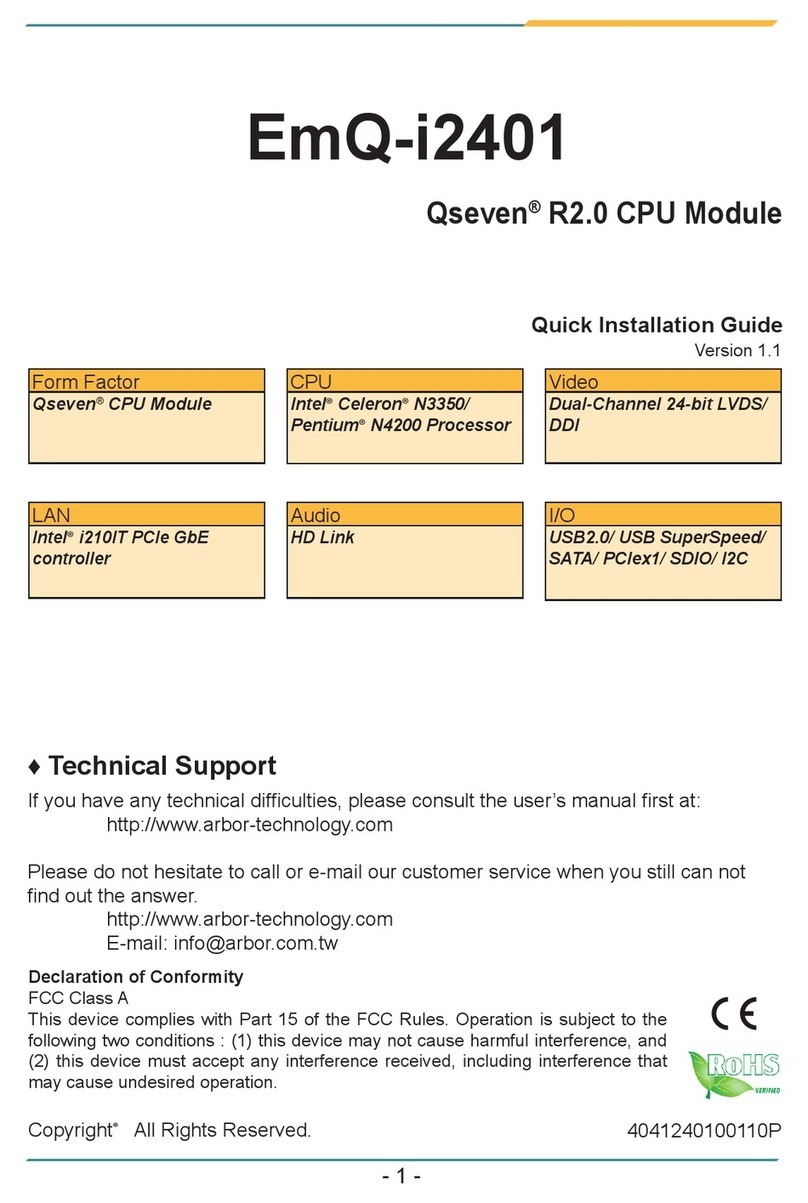BlueChip Solo User manual

SOLO
Single Board PC
User Manual


SOLO
User Manual
Document Part N°127-191
Document Reference SOLO\..\127-191.doc
Document Issue Level 0.5
Manual covers PCBs with the following Issue 1.x, A.x (x is any
alpha/digit)
All rights reserved. No part of this publication may be reproduced, stored in any retrieval system, or
transmitted, in any form or by any means, electronic, mechanical, photocopied, recorded or otherwise,
without the prior permission, in writing, from the publisher. For permission in the UK contact Blue Chip
Technology.
Information offered in this manual is believed to be correct at the time of printing. Blue Chip
Technology accepts no responsibility for any inaccuracies. The information contained herein is subject
to change without notice. There are no express or implied licences granted herein to any intellectual
property rights of Blue Chip Technology Ltd.
All trademarks and registered names acknowledged.
Blue Chip Technology Ltd.,
Chowley Oak, Tattenhall,
Chester, Cheshire,
CH3 9EX
Telephone : 01829 772000 Facsimile : 01829 772001

Amendment History
Issue
Level Issue
Date Author Amendment Details
0.1 25/04/97 EGW First Draft Issue
0.2 29/07/97 SEJ Updated modifications
0.3 15/08/97 BH Software section update
0.4 14/10/97 SEJ Amendments see ECN97/114
0.5 04/11/97 SEJ Amendments see ECN 97/126

CONTENTS
Blue Chip Technology Ltd. 127-191.doc
INTRODUCTION ..........................................................................................1
MANUAL OBJECTIVES.................................................................................1
LIMITATIONS OF LIABILITY.......................................................................1
PRECAUTIONS...............................................................................................2
ELECTRO-STATIC DISCHARGES...............................................................2
ON-BOARD BATTERY.................................................................................2
RELATED PUBLICATIONS ...........................................................................3
TRADEMARKS...............................................................................................3
USER GUIDE.................................................................................................4
OVERVIEW.....................................................................................................4
BOARD LEVEL FEATURES.........................................................................5
CPU .............................................................................................................5
PROCESSOR UPGRADE .............................................................................6
SECOND LEVEL CACHE ............................................................................6
SYSTEM MEMORY.......................................................................................6
BUS EXPANSION SLOTS.............................................................................7
ELECTROMAGNETIC COMPATIBILITY.....................................................7
SPECIFICATION.............................................................................................9
HARDWARE DESCRIPTION ....................................................................10
CHIPSET .......................................................................................................10
82439HX XCELERATED CONTROLLER (TXC).........................................10
PCI/ISA IDE XCELERATOR (PIIX3) ...........................................................11
UNIVERSAL SERIAL BUS (USB) ................................................................11
I/O CONTROLLER........................................................................................12
IDE SUPPORT ...........................................................................................12
SMC 37C932 SUPER I/O CONTROLLER.....................................................13
FLOPPY CONTROLLER ............................................................................13
KEYBOARD INTERFACE ..........................................................................14
REAL TIME CLOCK, CMOS RAM AND BATTERY....................................14
CHIPS & TECHNOLOGY GRAPHICS SUBSYSTEM...................................15
DISPLAY CAPABILITIES...........................................................................15
STANDARD VIDEO MODES......................................................................16
EXTENDED VIDEO MODES.....................................................................17
HIGH REFRESH VIDEO MODES..............................................................17
FLAT PANEL EXTENDED VIDEO MODES...............................................18
BIOS..............................................................................................................19
SYSTEM SETUP UTILITY ..........................................................................19
PCI SUPPORT............................................................................................19

CONTENTS
127-191.doc Blue Chip Technology Ltd.
ISA PLUG AND PLAY ................................................................................19
AUTO-CONFIGURATION CAPABILITIES.................................................20
ADVANCED POWER MANAGEMENT.......................................................20
SLEEP MODE SUPPORT...........................................................................21
SECURITY FEATURES ..............................................................................21
VIDEO BIOS..................................................................................................22
CONNECTING AN LCD TO SOLO ..............................................................22
BACK PANEL CONNECTORS ...................................................................25
ON-BOARD CONNECTORS.......................................................................25
BUS CONNECTORS...................................................................................26
JUMPERS.......................................................................................................27
CPU FREQUENCY SELECTION J4 & J5...................................................27
ON-BOARD VIDEO J6...............................................................................28
CMOS BATTERY SOURCE (CLEAR CMOS) J1 .........................................29
TABLE OF JUMPERS ................................................................................30
STATUS LEDS............................................................................................32
USER-INSTALLABLE UPGRADES..............................................................33
SYSTEM MEMORY.....................................................................................33
REAL TIME CLOCK BATTERY REPLACEMENT ......................................34
CPU UPGRADE.........................................................................................34
GRAPHICS MEMORY UPGRADE..............................................................34
SOFTWARE DESCRIPTION......................................................................35
BIOS SETUP - PROVISIONAL......................................................................35
OVERVIEW OF THE SETUP MENU SCREENS ..........................................35
MAIN SCREEN...........................................................................................35
OVERVIEW OF THE SETUP KEYS............................................................38
STANDARD SETUP....................................................................................39
ADVANCED SYSTEM SETUP ....................................................................41
ADVANCED CHIPSET SETUP...................................................................46
POWER MANAGEMENT SETUP ...............................................................48
PCI / PNP SETUP.......................................................................................51
PERIPHERAL SETUP ................................................................................55
SOLID STATE DISK SUPPORT....................................................................58
ADDRESS MAPS...........................................................................................59
MEMORY MAP...........................................................................................59
I/O MAP .....................................................................................................59
PCI CONFIGURATION SPACE MAP.........................................................61
INTERRUPTS & DMA CHANNELS............................................................63
CONNECTORS..............................................................................................64
BACK PANEL CONNECTORS ...................................................................64

CONTENTS
Blue Chip Technology Ltd. 127-191.doc
ECP/EPP PARALLEL PORT P18 TOP (26 WAY HEADER)........................64
ETHERNET UTP CONNECTOR P22 (8 WAY RJ45 )..................................66
INTERNAL I/O HEADERS .........................................................................66
FLOPPY DISK DRIVE CONNECTOR P12 (34 WAY HEADER)..................68
POWER CONNECTOR P4 (34 WAY HEADER)..........................................69
BATTERY CONNECTOR P1 (4 WAY HEADER).........................................71
BUS CONNECTORS...................................................................................71
ERROR MESSAGES .....................................................................................75
AMIBIOS ERROR BEEP CODES...............................................................75
AMIBIOS ERROR CODES ON THE POST DISPLAY .................................76
AMIBIOS ERROR MESSAGES...................................................................82
ISA NMI MESSAGES..................................................................................84
PCI CONFIGURATION ERROR MESSAGES.............................................85
BOARD LAYOUT.........................................................................................86

COMPANY PROFILE
127-191.doc Blue Chip Technology Ltd.
COMPANY PROFILE
Blue Chip Technology is the leading specialist PC product manufacturer in
UK/Europe.
Blue Chip Technology provides innovation with quality design and
manufacturing from a single source.
Based in the North West, our purpose built complex contains one of the most
advanced research and development facility, engineering workshop and
production lines.
Specialising in the provision of industrial computing and electronic solutions
for a wide range of UK and European organisations, Blue Chip Technology
has one of the UK's largest portfolios of industrial PCs, peripherals and data
acquisition cards. This extensive range of products, coupled with our
experience and expertise, enables Blue Chip Technology to offer an industrial
processing solution for any application. The SOLO Single Board PC is the
latest addition to our portfolio, providing a cost effective product development
and volume production tool for OEMs.
A unique customisation and specialised system integration service is also
available, delivering innovative solutions to customers problems. The
company's success and reputation in this area has led to a number of large
design and manufacturing projects for companies such as BNFL, Aston
Martin, JaguarSport and British Gas.
British Standards Institute approval (BS EN 9001) means that all of Blue
Chip Technology's design and manufacturing procedures are strictly
controlled, ensuring the highest levels of quality, reliability and performance.
Blue Chip Technology are also committed to the single European market and
continue to invest in the latest technology and skills to provide high
performance computer and electronic solutions for a world-wide customer
base.

SOLO USER MANUAL INTRODUCTION PAGE 1
Blue Chip Technology Ltd. 127-191.doc Page 1
INTRODUCTION
MANUAL OBJECTIVES
This manual describes in detail the Blue Chip Technology SOLO Single
Board processor card.
We have tried to include as much information as possible but we have not
duplicated information that is provided in the standard IBM Technical
References, unless it proved to be necessary to aid in the understanding of the
SOLO.
The manual is sectioned and includes a User Guide which will help the non
technical user to get the unit up and running. A Troubleshooting Guide is
also included to help when things go wrong.
We strongly recommend that you study this manual carefully before
attempting to interface with SOLO or change the standard configurations.
Whilst all the necessary information is available in this manual we would
recommend that unless you are confident, you contact your supplier for
guidance.
Please be aware that it is possible to create configurations within the CMOS
RAM that make booting impossible. If this should happen, clear the CMOS
settings, (see the description of the Jumper Settings for details).
If you have any suggestions or find any errors concerning this manual and
want to inform us of these, please contact our Customer Support department
with the relevant details.
LIMITATIONS OF LIABILITY
In no event shall Blue Chip Technology be held liable for any loss, expenses
or damages of any kind whatsoever, whether direct, indirect, incidental or
consequential, arising from the design or use of this product or the support
materials supplied with this product. If this product proves to be defective,
Blue Chip Technology is only obliged to replace or refund the purchase price
at Blue Chip Technology's discretion according to their Terms and
Conditions of Sale.

PAGE 2INTRODUCTION SOLO USER MANUAL
Page 2127-191.doc Blue Chip Technology Ltd.
PRECAUTIONS
It is imperative that precautions are taken to avoid electro-static discharges,
or any maltreatment of the on-board battery.
ELECTRO-STATIC DISCHARGES
The devices on this card can be totally destroyed by static electricity.
Ensure that you take necessary static precautions, ideally wear an approved
wrist strap or touch a suitable ground to discharge any static build up. This
should be repeated if the handling is for any length of time.
When carrying the board around, please place it into the non-conductive
bag in which it came. This will prevent any static electricity build up.
ON-BOARD BATTERY
This board is fitted with a Lithium battery. Great care should be taken with
this type of battery. Under NO circumstances should :
• the outputs be shorted
• be exposed to temperatures in excess of 100°C
• be burnt
• be immersed in water
• be unsoldered
• be recharged
• be disassembled
If the battery is mistreated in any way there is a very real possibility of fire,
explosion, and harm.

SOLO USER MANUAL INTRODUCTION PAGE 3
Blue Chip Technology Ltd. 127-191.doc Page 3
RELATED PUBLICATIONS
The following publications will provide useful information related to the
Standard Personal Computer and can be used in conjunction with this
manual.
• IBM Personal Computer AT Technical Reference, 1502494, IBM, 1984.
• IBM Personal System/2 and Personal Computer BIOS Interface Technical
Reference, 15F0306, IBM, 1987.
• The Programmers PC Sourcebook, Microsoft
• The Winn L. Rosch Hardware Bible, Brady
• PC104 Consortium Technical Specification
TRADEMARKS
IBM, PC, AT and PS/2 are trademarks of International Business Machines
Corporation (IBM).
AMI Hi-Flex BIOS is a trademark of American Megatrends Inc.
Intel is a registered trademark of the Intel Corporation.
All 80x86 and Pentium processors are registered trademarks of Intel
Corporation.
MSDOS and WINDOWS are registered trademarks of the Microsoft
Corporation.
PC/104 is a registered trademark of the PC/104 Consortium.

PAGE 4USER GUIDE SOLO USER MANUAL
Page 4127-191.doc Blue Chip Technology Ltd.
USER GUIDE
OVERVIEW
The Blue Chip Technology SOLO single board PC sets new standards for
integration of the latest advances in processor, memory, and I/O technologies.
The SOLO complies with the new A5 form factor providing ISA, PCI and
PC/104 bus interfaces on a single card. The A5 PC is an ideal platform for the
increasing requirements of today's and tomorrow's embedded applications.
The flexible design will accept Pentiumprocessors operating at 75, 90, 100,
120, 133, 150, 166 and 200 MHz, including MMX devices. The user may
install 256 KB of asynchronous Cache, or 256 KB or 512 KB of Pipeline
Burst Cache RAM in the form of a COAST (Cache On A STick) Module. The
memory sub-system is designed to support up to 64MB of EDO DRAM (for
improved performance) or standard Fast Page DRAM in standard 72-pin
SIMM sockets. An SPGA socket provides upgrades for future OverDrive
processors.
The SOLO single board PC utilises Intel’s Triton 82430HX PCIset to provide
increased integration and performance over other single board PC designs.
The Triton PCIset contains an integrated PCI Bus Mastering IDE controller
with a high performance IDE interface allowing up to two IDE devices (such
as hard drives, CD-ROM readers, etc.). The SMC 37C932 Super I/O
controller integrates the standard PC I/O functions: floppy interface, two
FIFO serial ports, one EPP/ECP capable parallel port, a Real Time Clock,
keyboard and mouse (PS/2) controller.
The SOLO also provides for driving up to three external ISA 16 bit expansion
slots.
In addition to superior hardware capabilities, a full set of software drivers and
utilities are available to allow advanced operating systems such as
Windows™ 95 to take full advantage of the hardware capabilities. Features
such as bus mastering IDE, Windows™ 95-ready Plug and Play, Advanced
Power Management (APM) are available for the SOLO.

SOLO USER MANUAL USER GUIDE PAGE 5
Blue Chip Technology Ltd. 127-191.doc Page 5
BOARD LEVEL FEATURES
• SPGA socket supporting 75 - 200 MHz operation
• On-board 3.3 V CPU voltage regulator
• Intel Triton 82430 PCISet chipset:
82439HX Xcelerated Controller (TXC)
PIIX3 PCI ISA IDE Accelerator (PIIX3) bridge
• 256KB or 512 KB PipeLine Burst Level 2 cache or 256 KB
Asynchronous Level 2 cache using plug-in COAST connector
• Two SIMM sockets providing up to 64MByte of EDO or FPM
DRAM
• C&T 65545/8 PCI CRT/LCD graphics controller with:
1 MByte standard video memory
• ISA & PC/104 expansion busses
• SMC 37C932 I/O controller providing:
Dual PCI IDE interfaces
Dual floppy interface
EPP/ECP bi-directional parallel interface
• 4 on-board RS232 powered serial ports. One port selectable as
RS422/485.
• Real-time clock with on-board battery
• PS/2 mouse and keyboard connectors
• Optional on-board Solid State Disk - Flash and SRAM
• Optional security microcontroller providing power monitoring and
reset control or magstripe and Dallas Touchkey interfaces
• On-board status LEDs
• Drive for up to 3 ISA or 3PC/104 cards
CPU
The SOLO single board PC is designed to operate with Pentium Processors
running at 3.3, 3.45 or 3.6 Volts. An on-board voltage regulator circuit
provides the required voltage for the processor from the 5 volt output of a
standard PC power supply. On-board jumpers enable the use of VRT
specified processors. Pentium processors which run internally at 75, 90,
100, 120, 133, 150, 166, 180 and 200 MHz are supported.

PAGE 6USER GUIDE SOLO USER MANUAL
Page 6127-191.doc Blue Chip Technology Ltd.
The Pentium processor maintains full backward compatibility with the
8086, 80286, i386and Intel486processors. It supports both read and
write burst mode bus cycles, and includes separate 8 KB on-chip code and
8KB data caches which employ a write-back policy. Also integrated into
the Pentium processor is an advanced numeric co-processor which
significantly increases the speed of floating point operations, whilst
maintaining backward compatibility with Intel486math co-processor and
complying to ANSI/IEEE standard 754-1985.
PROCESSOR UPGRADE
The SOLO single board PC has a 321-pin SPGA socket that provides users
with an OverDrive processor upgrade path. OverDrive processors being
developed for use will provide performance beyond that delivered by the
originally installed Pentium Processor. MMX CPUs are also supported by
SOLO.
SECOND LEVEL CACHE
The Pentium processor's internal cache can be complemented by a second
level cache using the COAST connector. Pipeline Burst SRAM provides
performance similar to expensive Synchronous Burst SRAMs for only a
slight cost premium over the slower performing Asynchronous SRAMs.
With the Triton chipset, the performance level of Pipeline Burst and
Synchronous SRAMs is identical.
SYSTEM MEMORY
The SOLO single board PC provides two 72-pin SIMM sites for memory
expansion. The sockets support 1M x 32 (4 MB), 2M x 32 (8 MB), 4M x 32
(16 MB), and 8M x 32 (32 MB) single-sided or double-sided SIMM
modules. Minimum memory size is 8 MB and maximum memory size,
using two 8M x 32 SIMM modules, is 64MB. Memory timing requires 70
ns fast page devices or, for optimum performance, 60nS EDO DRAM. If
the memory bus speed is 60 MHz or slower (75MHz, 90MHz, 120MHz,
150MHz or 180MHz Pentium Processor speed), 70ns EDO DRAM may be
used. If the memory bus speed is 66 MHz, 60 ns DRAM should be used.
Additionally, 36-bit SIMM modules may be used to provide either standard
parity operation or the parity circuitry can be used by the HX chipset to
provide ECC correction. EDO DRAM is designed to improve DRAM read
performance.

SOLO USER MANUAL USER GUIDE PAGE 7
Blue Chip Technology Ltd. 127-191.doc Page 7
The two sockets are arranged in a bank which provides a 64-bit wide data
path. There are no jumper settings required for the memory size or type,
this is automatically detected by the system BIOS.
BUS EXPANSION SLOTS
The SOLO is designed for use in an embedded application and provides
expansion slots. There may be up to three ISA bus expansion cards and
three PC/104 (PC/104 plus) expansion cards.
ELECTROMAGNETIC COMPATIBILITY
This product meets the requirements of the European EMC Directive
(89/336/EEC) and is eligible to bear the CE mark.
It has been assessed operating in a Blue Chip Technology PC. However,
because the board can be installed in a variety of computers, certain
conditions have to be applied to ensure that the compatibility is maintained.
Subject to those conditions, it meets the requirements for an industrial
environment (Class A product).
• The board must be installed in a computer system chassis which
provides screening suitable for an industrial environment.
• Any recommendations made by the computer system
manufacturer/supplier must be complied with regarding earthing and
the installation of boards.
• The board must be installed with the optional backplate securely
screwed to the chassis of the computer to ensure good metal-to-metal
(i.e. earth) contact.
• Most EMC problems are caused by the external cabling to boards. It is
imperative that any external cabling to the board is totally screened, and
that the screen of the cable connects to the metal end bracket of the
board and hence to earth. It is recommended that round screened cables
with a braided wire screen are used in preference to those with a foil
screen and drain wire. Use metal connector shells which connect
around the full circumference of the screen: they are far superior to
those which earth the screen by a simple “pig-tail”.

PAGE 8USER GUIDE SOLO USER MANUAL
Page 8127-191.doc Blue Chip Technology Ltd.
• The keyboard will play an important part in the compatibility of the
processor card since it is a port into the board. Similarly, it will affect
the compatibility of the complete system. A fully compatible keyboard
must be used otherwise the complete system could be degraded. The
keyboard itself may radiate or behave as if keys are pressed when subject
to interference. Under these circumstances it may be beneficial to add a
ferrite clamp on the keyboard lead as close as possible to the connector.
A suitable type is the Chomerics type H8FE-1004-AS.
• Ensure that the screens of any external cables are bonded to a good RF
earth at the remote end of the cable.
Failure to observe these recommendations may invalidate the EMC
compliance.
Warning
This is a Class A product. In a domestic environment this
product may cause radio interference in which case the user
may be required to take adequate measures.

SOLO USER MANUAL USER GUIDE PAGE 9
Blue Chip Technology Ltd. 127-191.doc Page 9
SPECIFICATION
SOLO Power +5 V ± 5% Required for processor operation.
Requirement +12 V ± 5% Only required with security / monitor
micro-controller option.
+3.3 V ± 5% Not required for board operation.
-5 V ± 5% The ISA, PC104 & PCI voltage
-12 V ± 5% rails are linked, on board.
Typical System
Consumption 35 Watts Pentium 100, 16 MB RAM, 256 KB
L2 cache, 3½" FDD, 540 MB HDD
Temperature Non-Operating -40°C to +70°C
Operating +0°C to +55°C
(min. airflow of 200 lpm)
Shock Non-Operating Half sine, 2ms, 1 m drop
Vibration Non-Operating 5 Hz - 500 Hz, 3.1 g RMS random
Operating 10 Hz - 500 Hz, 1.0 g RMS random
EMC Emissions EN55022 (A)
Immunity EN50082-2 in a Blue Chip ICON
Industrial PC Chassis
MTBF Estimated 40,000 Hrs
Dimensions Board only 338 x 122 mm
Power Consumption figures given are for a typical configuration.
This information is preliminary and is provided only as a guide to
calculating approximate total system power usage when additional
resources are added.

PAGE 10 USER GUIDE SOLO USER MANUAL
Page 10 127-191.doc Blue Chip Technology Ltd.
HARDWARE DESCRIPTION
CHIPSET
The Intel 82430HX PCIset consists of the 82439HX Xcelerated Controller
(TXC) and one 82371SB PCI/ISA IDE Xcelerator (PIIX3) bridge chip.
82439HX XCELERATED CONTROLLER (TXC)
The 82439HX provides all control signals necessary to drive a second level
cache and the DRAM array, including multiplexed address signals. The
TXC also controls access to memory and generates snoop controls to
maintain cache coherency. The TXC comes in a 324-pin BGA package and
includes the following features:
• Microprocessor interface control
• Integrated L2 write-back cache controller
Pipeline burst SRAM
256 KB direct-mapped
• Integrated DRAM controller
64 bit path to memory
Support for EDO and fast page DRAM
Parity and non-parity support
• Fully synchronous PCI bus interface
25/30/33 MHz bus speed
PCI to DRAM > 100 MB/sec
Up to four PCI masters in addition to the PIIX3

SOLO USER MANUAL HARDWARE DESCRIPTION PAGE 11
Blue Chip Technology Ltd. 127-191.doc Page 11
PCI/ISA IDE XCELERATOR (PIIX3)
The PIIX3 provides the interface between the on-board PCI and ISA buses
and integrates a dual channel fast IDE interface capable of supporting up to
four devices. The PIIX3 integrates seven DMA channels, one 16-bit
timer/counter, two eight-channel interrupt controllers, PCI-to-AT interrupt
mapping circuitry, NMI logic, ISA refresh address generation, and PCI/ISA
bus arbitration circuitry together onto the same device. The PIIX3 comes in
a 208-pin QFP package and includes the following features.
• Interface between the PCI and ISA buses
• Universal Serial Bus controller
Host/hub controller
• Integrated fast IDE interface
Support for up to four devices
PIO Mode 4 transfers up to 16 MB/sec
Integrated 8 x 32-bit buffer for bus master PCI IDE burst transfers
Bus master mode
• PCI 2.1 compliant
• Enhanced fast DMA controller
• Interrupt controller and steering
• Counters/timers
• SMI interrupt logic and timer with fast on/off mode
UNIVERSAL SERIAL BUS (USB)
The SOLO single board PC features two USB ports as a factory installed
option. The ports permit the direct connection of two USB peripherals
without an external hub. If more devices are required, an external hub can
be connected to either of the built-in ports. The motherboard fully supports
the standard universal host controller interface (UHCI) and uses standard
software drivers that are UHCI-compatible.

PAGE 12 USER GUIDE SOLO USER MANUAL
Page 12 127-191.doc Blue Chip Technology Ltd.
Features of the USB include:
• Self-identifying “hot pluggable” peripherals
• Automatic mapping of function to driver and configuration
• Support for isochronous and asynchronous transfer types over the same
set of wires
• Support for up to 127 physical devices
• Guaranteed bandwidth and low latencies appropriate for telephony, audio,
and other applications
• Error handling and fault recovery mechanisms built into protocol
NOTE
Computer systems that have an unshielded cable attached to the USB port
might not meet FCC Class B requirements, even if no device or a low speed
(sub-channel) USB device is attached to the cable. Use shielded cable that
meets the requirements for high speed (fully rated) devices.
I/O CONTROLLER
IDE SUPPORT
The SOLO single board PC provides two independent high performance
bus-mastering PCI IDE interfaces capable of supporting PIO Mode 3 and
Mode 4 devices. The system BIOS supports Logical Block Addressing
(LBA) and Extended Cylinder Head Sector (ECHS) translation modes as
well as AT API (e.g. CD-ROM) devices on both IDE interfaces. Detection
of IDE device transfer rate and translation mode capability is automatically
determined by the system BIOS.
In the Windows™ 95 environment, a driver can allow the IDE interface to
operate as a PCI bus master capable of supporting PIO Mode 4 devices with
transfer rates up to 16MB/sec while minimising the system demands upon
the processor. Normally, programmed I/O operations require a substantial
amount of CPU bandwidth. In true multi-tasking operating systems like
Windows™ 95, the CPU bandwidth freed up by using bus mastering IDE
can be used to complete other tasks while disk transfers are occurring.
Table of contents
Other BlueChip Single Board Computer manuals

